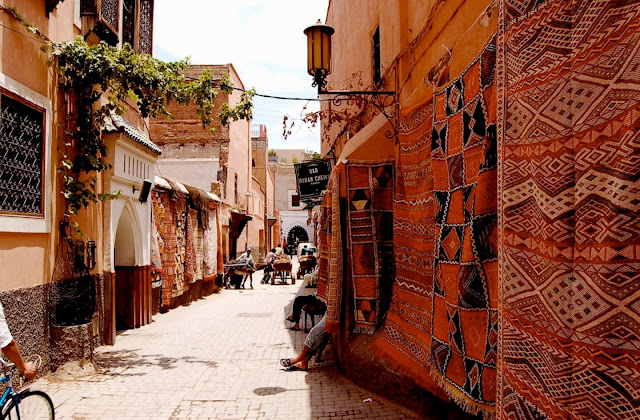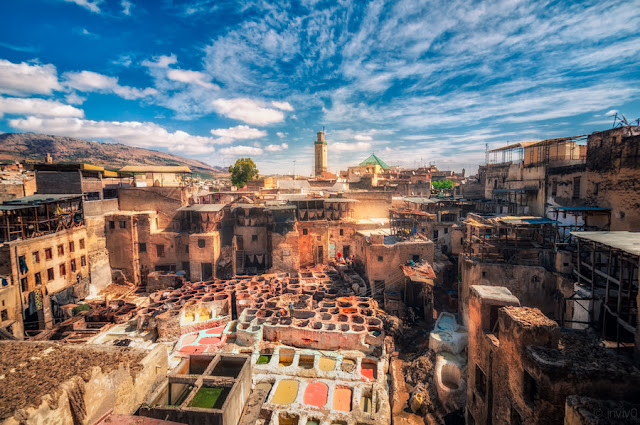I have recently found a passion for Moroccan cuisine, it is amazing the vast array of influences to their cuisine. Interestingly, the French are far less involved with the development of their food than I would have thought.
Here is some research that I recently did into Moroccan cuisine, it maybe of interest to some of you! Enjoy!
Al Mamlakah al Maghribiyah (The Kingdom of Morocco)
To understand any cuisine, especially the history, or origins, of food styles and commodity usage we need to look at a few relevant factors. It is also worth considering that
Morocco has had such a variety of influences that it is very difficult to say one particular influence is the corner stone of Moroccan cuisine.
A BRIEF HISTORY OF MOROCCO:
Morocco has a long history spanning approximately 3300 years, and was originally inhabited by the indigenous Berbers. The Byzantine Empire ruled Morocco during the 6th century, followed by perhaps the most prominent influence upon Morocco, the 7th Century AD invasion by the Moors and the establishment of the first Arabic Muslim dynasty. The Ottoman Empire later ruled much of North Africa, including Morocco, during much of the middle ages. Centuries later, in 1912, Morocco was split into two protectorates, French and Spanish.
Initially the Berbers focused on Tagines and couscous, followed by the Arabs who introduced new spices, dried fruits and nuts. The Moors introduced olives and citrus, while the Jews introduced pickling and preserving techniques. The Ottoman Empire introduced kebabs; the French introduces cafes, pastries and reinvigorated the wine industry.
These broad and diverse cultural, geographic and religious influences have each impacted upon Moroccan cuisine over the ages. For example, prior to the Byzantine Empire's control of Morocco, the area was one of the world's major producers of wine and exported large quantities to Rome, after the invasion the vineyards were removed with the exception of edible grapes.
With this enormous exposure to differing styles of food, Morocco is considered to have one of the world's most important cuisines. This diversity of influences has come together through the uniquely Moroccan blend of spices which contain a "medley of spices"; dried ginger, cumin, salt, black pepper and turmeric. Interestingly, cumin, a spice that was used frequently in ancient Greek and Roman dishes, is used in virtually every Moroccan dish.
As with all cuisine, geography and climate play a large part in the historical formation of cuisine. As Morocco is located on the north western part of Africa, it has a large coastline and an ideal climate for growing of fruit and vegetables, while the interior of the country is perfect for raising sheep and goats.
MENU AND SERVICE STRUCTURE:
As with most Western cuisine, Morocco follows the same format of dining, including, salads, main dishes, desserts and sauces.
The midday meal is often the main meal (with the exception of Ramadan) and would begin with hot and cold salads, followed by a tagine; bread is also eaten with every meal. The tagine will often contain meat (lamb or chicken); followed by dessert.
The Moroccans will eat with their hands, utilising bread as the utensil. They will dine at a small round table sitting on cushions on the floor.
We can sum up Moroccan cuisine by highlighting the extensive use of spices, fruits, condiments and herbs, all culminating in a range of exciting and explosive flavours and cooking techniques.
CUISINE SUMMARY
Morocco:
Lamb, Chicken, Beef, Camel, Rabbit, Seafood, Nuts, Chickpeas and seeds (dried beans are also a popular breakfast protein).
Couscous is the predominant starch of Moroccan cuisine; followed by bread, and potatoes.
Tomatoes, eggplant, zucchini, capsicum, carrots, pumpkin and garlic are the main vegetables. However, Moroccan cuisine covers an enormous array of fruit and vegetables due to the ideal coastal growing areas available.
Fruits consist of oranges, grapefruits, lemons, melons, plums, apricots, grapes, figs, and dates.
Flavourings:
Coriander, parsley, cumin, saffron, cinnamon, cumin, pepper, turmeric and ginger are the key flavours found in Moroccan dishes. Paprika is also used, but not overly common. Also, basil, marjoram, olives and preserved lemons are used as flavourings.
Cooking methods:
Predominantly stewing, or simmering slowly as well as steaming (for hot or cooked foods). For many salads, cooking is not required.
Traditional Dishes:
Zaalouk - Eggplant and Tomato Cooked Salad, served with bread.
Zaalouk is a typical starter (entree), this dish is simple to make and came about by the large amount of eggplant and tomatoes grown in Morocco. The dish contains vegetables with flavorings that would nicely complement a meal, and while it is simmered in a pot, would retain most of its nutritional value - especially as Moroccan main dishes are predominantly meat (protein).
INGREDIENTS
- 1 large eggplant, peeled and chopped*
- 4 large tomatoes, peeled, seeded and chopped
- 3 cloves of garlic, finely chopped or pressed
- 1/3 cup chopped fresh cilantro and parsley, mixed
- 1 tablespoon paprika
- 1 tablespoon cumin
- 1 1/2 teaspoons salt
- 1/8 teaspoon cayenne pepper (optional)
- 1/4 cup olive oil
- 1/3 cup water
- small wedge of lemon (optional)
Couscous - (the name is derived from the Berber language meaning rolled or well formed) and is main starch in Moroccan Cuisine, served with meat or vegetable stews.
Couscous is a manufactured product with semolina rolled into small pellets and sprinkled with flour to keep the pallets separate. Couscous also contains protein (3.6%); however it is considered a CHO as its 36% complex CHO. Served steamed also assists in retaining the nutritional integrity of the dish.
Tagine - historically a Berber dish and refers to the conical clay pot that the dish is cooked in.
Moroccan Meatball Tagine
This Moroccan Meatball Tagine is typical of Moroccan tagines, containing lamb as the primary ingredient and main protein of the diet, with many spices "medley of spices", to flavour the dish. The dish is slow cooked via simmering in the Tagine and served with Couscous, therefore encompassing protein, carbohydrates, sauce, flavourings and starch. The vegetable component of the meal has already taken place in the salad that is traditionally used as a starter.
INGREDIENTS
- 500gm Minced Lamb or Beef
- 1 Onion
- 3/4 cup olive oil
- Bunch of coriander
- 1 tbs ground fennel seeds
- 1 tbs smoked paprika
- 1 tbs ground cumin
- 1 tbs ground coriander seeds
- 2 tsp ground black pepper
- Salt (to taste)
- Tin of diced tomatoes (425gm)
- 3 garlic cloves
- 1/2 preserved lemon (optional)
- Juice of 1/2 lime
Metaxas - Baklava, while known as a Turkish or Greek dish, baklava is also very much a traditional dish to Morocco, again highlighting the mix of cultures throughout this countries culinary history. While the Moroccans traditionally eat fruit for dessert, they don't hesitate to indulge in sweets as well. Metaxes offer Moroccans exposure to both fibre and vegetable proteins via the combination of nuts. While this dish is high in simple sugars the quantity the Moroccans eat of such a dish is relatively small (as they eat desserts with fruit) which has traditionally helped to keep the Moroccan diet balanced and structured around all food groups. Although in the current era, 40% of Moroccan women are now either overweight or obese, predominantly in the urban areas, suggesting a move away from the traditional, well balanced Moroccan diet.
INGREDIENTS
- 2 1/2 cups sugar
- 1 1/4 cups water
- 1 orange peel (no pith)
- 1 lemon rind (no pith)
- 5 whole cloves
- 1 cinnamon stick
- 1/2 cup honey
- 1 teaspoon orange flower water
- 3/4 cup walnuts, finely chopped
- 3/4 cup pistachios, finely chopped
- 1/2 cup lightly toasted, blanched almonds, chopped
- 1/2 cup caster sugar
- 1 teaspoon rose water
- 1 teaspoon ground cinnamon
- 1 1/4 pound unsalted butter, melted
- 1 package filo pastry sheets
For the syrup, combine the sugar, water, orange and lemon rinds, cloves and cinnamon stick in a saucepan. Bring to boil. Simmer, uncovered, about 5 minutes, to thicken syrup slightly. Remove from heat. Discard spices and rinds. Stir in honey and orange flower water. Cool to room temperature.
Combine nuts, sugar, ground cinnamon and rosewater.
Brush a 13x9x2-inch baking pan well with butter.
Separate 25 phyllo sheets from the package. Place under a smooth, damp towel to prevent the phyllo from drying out. Wrap remaining phyllo well and freeze for future use.
Place one phyllo sheet in buttered pan. Trim to fit. Brush generously with melted butter. Repeat procedure until there are 5 layers of buttered phyllo in the pan. Sprinkle with 1/4 nut mixture. Repeat this procedure two more times, ending with phyllo.
Drizzle any remaining butter over top. Bake in 350 degree oven 1 1/2 hours, or until golden brown. Remove baklava from oven. Using a sharp knife immediately cut long, diagonal lines from corner to corner, forming an "X" design. Follow these guidelines to cut baklava into serving-size diamonds. While still hot, pour cooled syrup over baklava. Let stand overnight before serving.






